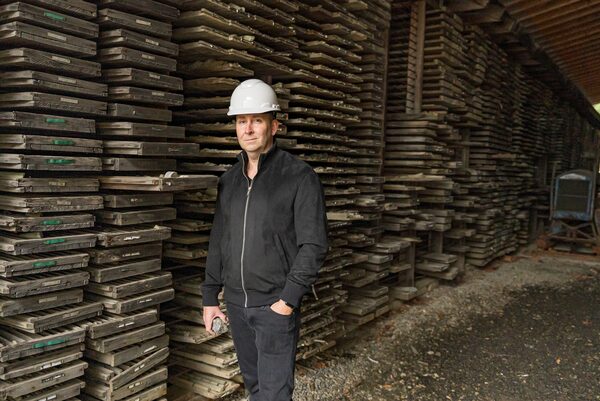Kendra Johnston, President of the Association for Mineral Exploration BC, at Vancouver’s Canada Place overlooking the Port of Vancouver on Dec. 1.Alia Youssef/The Globe and Mail
Mining companies are facing long delays getting new equipment and transporting shipments because of supply chain problems, as the effects of the pandemic, labour shortages, increased demand for raw materials and metals, and natural disasters continue to create disruptions globally.
Smaller exploration companies say they are unable to find drills, and turnaround times for necessary lab tests have tripled, which is hindering their ability to raise funds on the public markets. Meanwhile, larger companies already operating mines are seeing increased transport costs and delays shipping materials both in and out of their facilities, causing some to shut down where there is no more room for additional inventory.
“Two or three years ago, I could make a phone call and I had a drill within a week,” said Warwick Smith, chief executive officer of American Pacific Mining Corp., an exploration company based in Vancouver. “Now I just can’t find one. You don’t know how hard I’ve worked for the last three months to try to get a drill.”
Mr. Smith estimated that at each of American Pacific’s four mining projects in the United States, costs have increased 25 per cent to 30 per cent compared with prepandemic levels because of supply chain issues.
The challenges facing Canada’s mining companies are a reverberation of those plaguing the global supply chain, which has been disrupted for nearly two years as a result of factory shutdowns and sustained, heightened demand.
In a recent analyst calls, Vancouver-based mining company executives noted the effects on their bottom lines. In October, Donald Lindsay, president of Teck Resources Ltd., said that inflationary pressures, wildfire disruptions and increased ocean freight rates continued to put pressure on transport costs. Tristan Pascall, CEO of First Quantum Minerals Ltd., said the company’s staff were fighting “in the trenches” to get their containers on ships.
Toronto-based Canadian gold companies, too, are feeling the effects of delayed supplies. In November, Natasha Nella Dominica Vaz, chief operating officer of Kirkland Lake Gold Ltd., mentioned that batteries and power equipment were in low supply. Meanwhile, Gordon Stothart, president of Iamgold Corp., said overall friction in the supply chain was “generating some spiky results.”
Revenue at B.C. mining companies dropped $2-billion in 2020 compared to 2019, according to the Mining Association of British Columbia. The association said this was largely because of reduced shipments and lower prices for steel-making coal, a key commodity for the province’s mining industry.
While it’s hard to know how much of that loss was owing to supply chain issues directly, Kendra Johnston, president of the Association for Mineral Exploration, said the effect was “substantial.” The effects continue: In recent months, fires and flooding in B.C cut off transport between ports and mines, prompting mining companies to slow down or stop production entirely at some locations. It has also become more difficult to transport materials to the mines to continue operating machinery.
“You need to be able to get gas and diesel to the camps, and so they get shut down when we don’t have that supply chain there,” said Ms. Johnston.
Mike McPhie, vice-president of mid-sized exploration company Talisker Resources, said his company lost access to its Ladner Creek mine near Hope, B.C., because of blocked access routes. Now, he said it could be months before they have reliable access again. Flooding has also presented challenges transporting staff and goods to other mines in the province.
“All our supply routes and employee corridors are linked. So when these supply routes get affected, we really feel it,” Mr. McPhie said.
Local supply chain snags are a particular problem for small companies that rely on quick turnarounds for “assays,” which are drilled cores of rock that are analyzed in a lab to determine if they contain ore or minerals. These exploration companies often have limited budgets for on-site work – sometimes enough for just a few months – so getting results back right away is crucial for drilling strategically.
Prior to the pandemic, the turnaround time for assay results was about 20 days, but this year results are taking as long as 75 days, said Joness Lang, vice-president of Maple Gold Mines, an exploration company in Northern Quebec. He said these delays can have far-reaching influence.
“You’re under a lot of pressure to turn around and get those drill results out to the public market, which can impact your share price, which then impacts your ability to raise more money and advance your projects,” said Mr. Lang. “Those delays can be very critical.”
The cost of shipping materials and storage have doubled as well for his company, Mr. Lang said. The wooden core boxes that hold the extracted samples, for example, have more than doubled in cost, to up to $13 from $5. For a company extracting 100,000 samples at a time, he said, this figure starts to add up quickly.
HLS Hard-Line Solutions Inc., a Sudbury-based company that makes automated mining vehicles and electronics, said delivery times from its suppliers are skyrocketing. Vice-president France Dubois Hnatiuk said in an e-mail that certain electronic products that used to typically arrive from their suppliers in one week are now taking 20 weeks, and have increased in price by a third. Meanwhile, wait times for cables and packaging have more than doubled.
Similarly, executives at U.S.-based Caterpillar Inc., the largest manufacturer of mining equipment in the world, said in October they were working to combat supply chain challenges, with higher manufacturing costs and longer transport times posing a problem for the company.
“We believe our sales in the third quarter would have been higher, if not for these issues,” Caterpillar chief operating executive Jim Umpleby said in a recent earnings call with analysts.
For some larger mining companies already in production, the issue is less about securing equipment and more about transporting raw materials.

Warwick Smith, CEO of American Pacific Mining.American Pacific Mining
As Canada is the second-largest country in the world by landmass, some products need to move farther to get to a port than they do in almost any other country, noted Brendan Marshall, vice-president of economic and northern affairs for the Mining Association of Canada. This makes Canadian mining companies particularly dependant on transport – and highly vulnerable to disruptions.
“In Canada, mining products account for over 50 per cent of rail freight volumes in the country, so mining companies are the single-largest corporate customer group of Canada’s railways. And there’s similar volumes moved by marine transportation as well,” Mr. Marshall said.
With limited inventory storage on-site, mines that find their outbound transport streams slowed will run out of room quickly and be forced to stop production, Mr. Marshall said.
Some companies that own more of their supply chain are facing fewer disruptions. ArcelorMittal Infrastructure Canada, a producer of steel and ore, owns its own dedicated transport railway linking the Mont-Wright mine in Fermont, Que., to its facilities in Port-Cartier, on the north shore of the St. Lawrence River.
According to Suresh Kalagara, Arcelor’s general manager of supply chain, this has helped the company avoid some issues within Canada. But the company still has disruptions from the bottleneck at California’s Port of Los Angeles, the busiest in the U.S.
Elsewhere, container transport prices have remained high. Jean Simard, president of the Aluminium Association of Canada, based in Montreal, said a container travelling to Montreal from Hamburg, Germany, which would have cost $2,000 before the pandemic, now goes for $14,000.
Mr. Simard said the past two years have highlighted the fragility of long global supply chains. He expects to see companies relying less on imported materials from other countries when possible, or companies developing stronger vertically integrated supply networks they can control.
“We will probably see a shift from long intercontinental supply chains, to shortened supply chains in the future,” Mr. Simard said. “There will be a price to pay, but the market will have to bear the price.”
Your time is valuable. Have the Top Business Headlines newsletter conveniently delivered to your inbox in the morning or evening. Sign up today.
 Irene Galea
Irene Galea